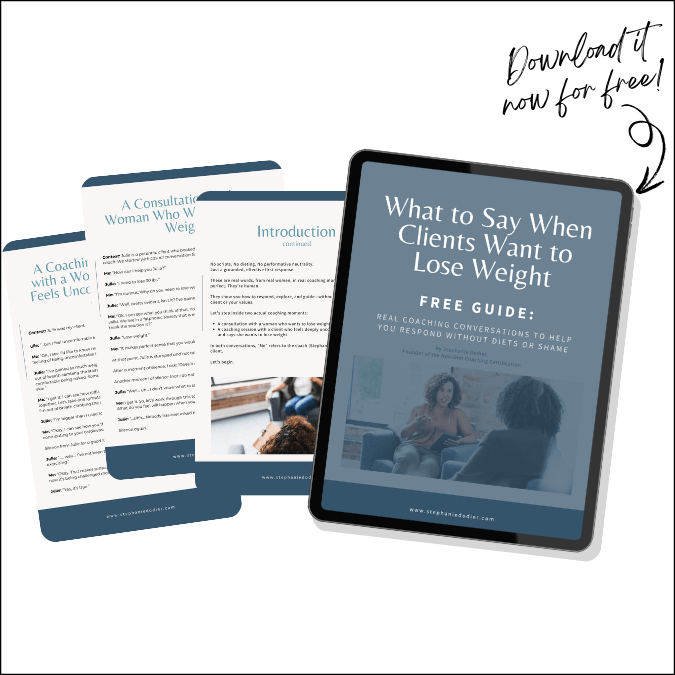

In this first episode of my brand-new mini-series Coach Corner, I’m diving into two core challenges we all face when supporting clients: gentle nutrition versus restrictive eating, and how to help clients reconnect with hunger and fullness cues. This series is especially for my fellow Health Pros—dietitians, therapists, nutritionists, and coaches—who want to support clients without falling into the traps of diet culture.
In this short and impactful conversation, I answer two listener-submitted questions straight from our recent survey. I share practical coaching strategies, key mindset shifts, and powerful tools to help your clients embrace food choices from a place of care—not control. If you’re coaching eating behaviors and want your work to be rooted in self-trust and embodiment, this one’s for you.
Episode Timeline & Highlights
[2:22] – Why “gentle nutrition” isn’t neutral—and how our cultural baggage plays into it
[4:00] – The true intention behind gentle nutrition vs restrictive eating
[6:11] – Three client capacities to build before introducing gentle nutrition
[7:06] – Powerful coaching questions to foster body-led eating
[9:00] – Helping clients rebuild interoceptive awareness after restriction
[12:15] – Somatic techniques to support reconnection with hunger cues
[14:46] – Coaching practices to develop fullness awareness (without triggering restriction)
Mentioned in the show:
Non-Diet Coaching Certification Waitlist
Non-Diet Coaching Client Assessment Tool
Full Episode Transcript
This transcript was auto-generated and lightly edited for clarity.
Click to expand the full transcript
How can coaches teach Gentle Nutrition without becoming restrictive?
Coaches can teach Gentle Nutrition without becoming restrictive by focusing on intention, not rules. Instead of labeling foods as “good” or “bad,” they guide clients to explore how different foods make them feel—physically and emotionally. By building interoceptive awareness, emotional regulation, and cognitive flexibility, clients learn to make choices from self-care, not control. The goal is to foster trust in the body, not rely on external rules.
[00:00:00] Welcome to It’s Beyond the Food Podcast, my sisters. I’m your host Stephanie Dozier, and today we’re doing something brand new on this podcast and I’m introducing a new miniseries called coach Corner. The series is for all of you, my Health Pro, dietician, nutritionist, therapist, health coaches, all the people that help the people talk about health Coach on health counsel on health without reinforcing diet culture.
[00:00:30] My intent on this miniseries, I have no idea where this is going. By the way, I had this idea yesterday, Saturday. I’m like, let’s do this. I think it’s gonna help hundreds and hundreds of coaches, so let’s figure it out as we go. By the way, that’s a great business lesson, which is gonna figure it out as a go.
[00:00:50] Here’s the boundaries of this series. Number one. Questions are coming from you. We did our biannual survey in my company [00:01:00] in October, and we asked the question what question you would like me to answer. These are some of those questions. And then two, this is where the biggest challenge for me comes in.
[00:01:13] I cannot exceed 15 minutes. If you are watching on YouTube, you’re seeing how my eyes are big. This is a real big challenge for me because I like to blabber. I like to explain things, I like to teach things. I like to conceptualize things, and this is gonna force me to really be proficient and giving you an answer within like seven to eight minutes.
[00:01:36] ’cause here’s the challenge. I want to answer two question per episode of this mini series. We’re gonna tackle all the questions that are health promoting behavior, that are eating behavior, that are body image mindsets and even maybe some business one. I don’t know we’re, I know I’ve received a ton of business [00:02:00] question.
[00:02:00] We’ll see if we get into answering some of those questions. So. Here’s my first exception to this 15 minute rule, not this episode, because this episode I have to introduce this mini series. Uh, so I don’t want that time to cut into answering my question, so I’m gonna start the timer to answer the two question in about two minutes.
[00:02:26] So I wanna say this is a little bit longer. The next episode, we’re gonna jump in right to reading the question and me giving you answer. Are you ready? Let’s see where that goes. Today is November the second. Let’s see what happened with this in weeks and months to come.
[00:02:47] All right, let’s dive in. All right, two questions for today. How do you draw the line between gentle nutrition and restrictive eating? And then question number two, how can you help [00:03:00] your client reconnect with their hunger and fullness queue? Now, both are core challenges in our space, and both can easily slide back our client into diet culture through failure in.
[00:03:17] Either gentle nutrition or reconnecting with hunger and fullness. Now, before we talk on the first question of gentle nutrition, we have to remember something very important. Nutrition is not neutral in our culture. For generation like last three to four generation women have used food to control our body and to prove our discipline, our worth, and our.
[00:03:47] Moral virtue into this world. So when your client come and engage you in gentle nutrition, it is very likely that they’re coming at the concept of [00:04:00] gentle nutrition from a place of finally being able to eat healthy. I heard that when I was with general population over and over again. People were anxious in the first stages of intuitive eating and.
[00:04:13] When I query through coaching question where was that anxiety coming from? It’s like, when can we finally talk about healthy eating? So. I’ve learned from that, and I started to position Gentle Nutrition from the very first few session to make sure my client, weren’t aiming to finally eat healthy with gentle nutrition.
[00:04:36] So our, our job is to really not reinforce the concept of healthy eating or even rules, but to use gentle nutrition as a space. As a concept to help further our client self-trust and body connection. Instead of controlling, we reemphasize [00:05:00] the concept of empowerment and choices. So that’s the line. The intention we place behind gentle nutrition and also emotional safety.
[00:05:11] Gentle nutrition is a regulation skill. Inside the non diet coaching certification, we teach that gentle nutrition is not about learning nutrition facts and science. In fact, by the way, in the non diet coaching certification, I don’t share any study because that’s not study and intellectual information is not what actually changed the behavior of our client, but it’s being able to have some information.
[00:05:41] And being able to use that knowledge safely. And that requires three skillset, three capacity that we need to help our client build cognitive safety. So being free from diet thinking and all or nothing, thinking black and white thinking, [00:06:00] emotional regulation. . Being able to make choices without fear and guilt and interoceptive awareness, sensing our body skews and feedback, if those aren’t in place, getting to gentle nutrition will likely be given an interpretation from your client’s brain as restriction.
[00:06:25] Once again. Once again, I’m gonna have a list of healthy and unhealthy food and I’ll be able to lean on external cue to tell me how to eat because they feel uncomfortable not controlling their food. One thing you wanna be careful about understanding all those concepts is the language you use around gentle nutrition.
[00:06:51] I am going to give you here three coaching question that you can use when it comes to gentle [00:07:00] nutrition to help you talk about gentle nutrition in a completely different way.
[00:07:06] And the number one thing when we wanna move client away from rules is instead seeking internal cue to know which food works for them and which food doesn’t work for them. And that’s where the interoception awareness, at least the baseline of it, and the understanding of it, has to be implemented in your client in order to facilitate gentle nutrition from a place of sensation in the body instead of.
[00:07:35] Intellectual rules. So here’s a trick question. What food helps you feel grounded and steady throughout the day? What food leaves you comfortably satisfied and energized? What changes do you notice when you include more fill in the blank [00:08:00] protein, fats, or carbs into your meal? And again I hope you notice that none of this has an answer from us as a coach.
[00:08:09] It’s question that we ask our clients so they find the answer within them. So we invite exploration, curiosity. Instead of us telling them what they should feel and what they should eat. So that’s what we call collaborative coaching. And that’s one of the angle of coaching that we use within the non-diet coaching certification.
[00:08:32] So these were my tips to separate gentle nutrition and restrictive eating. A second question that I want to target today is kind of working off this first one, which is helping our clients, specifically those that have been restrictive eater and restrictive eater, either from a place of managing body size or healthism eating quote unquote healthy.[00:09:00]
[00:09:00] So how do we help our client feel their hunger and their fullness now? In order for a client to feel their hunger and fullness, they have to tap into an innate skillset, which is called interceptive awareness, the ability to sense our inner world, and I want you to think of interception awareness as a dial on the stove.
[00:09:28] So when we restrict our eating, either from a dieting, shrinking the body or healthy eating, what we do is we dull or we reduce our ability to sense our inner world in favor to intellectual, cognitive rules, but we never completely shut it down. We actually may, if, if you imagine a dial on a stove being from one to 10, we have the dial cranked down [00:10:00] to two instead of nine or 10, right?
[00:10:04] So we, in a way, in a protective effort, our body as dialed down our capacity to sense our inner world to protect us from crossing the rules or not performing the meal plan. So that we can follow the cognitive rules because for whatever reason, that’s what we were told were the right thing to do. So our bodies actually was working with us and reducing the sensitivity to feel our inner world.
[00:10:35] So our work with our client is going to be to bring that dial from a two to a tens or to a nine, like maybe not a hundred percent, but like a eight, nine tens. That’s your work as a coach to do that with them. Now I’m using the analogy of the dial in the stove because I use a ton of analogy when I coach client, giving them [00:11:00] a visual goal, like an explanation of something that is not three dimensions for them. When we talk about inter interoception awareness, they’re like, what is that? So when I give them a visual, like the dial stove, it helps them visualize what they’re trying to do.
[00:11:17] I’m gonna teach you another concept here, which is normalization. So when you first start, usually when we’re talking about hunger and fullness, that’s the beginning stages of eating, behavior, coaching, when we reset the baseline. So the first thing we wanna do when client come and they’re challenged with feeling their hunger.
[00:11:36] Enough fullness is to normalize it and it’s to tell them it’s 100% normal for you to not feel hunger and fullness and give them the exact explanation I just gave you. It’s a safety protocol that your body did in order for you to be able to. Sense or follow the rules of the plan or the program you were on.
[00:11:56] And our journey together will be to [00:12:00] increase your sensitivity and to map your inner world and the sensation of hunger. Fullness. And don’t forget satisfaction too. I get it. We start with hunger and fullness, but we very quickly have to bring in the concept of satisfaction.
[00:12:15] One of the thing that I do with my client, or that I recommend you do with your client is to, again, because interoception awareness is. Not something people can touch and sense, right? It’s happened in their body is to bring in the sensation of touch. So if you’re watching me on YouTube right now, I have both of my hands and I’m placing them on my stomach.
[00:12:42] And so as we do the hunger and fullness scale with our clients, we can have them touch their stomach and ask, am I hungry right now? How does my hunger feel right now in my body and somatically when we bring the [00:13:00] touch to our body around the stomach? Here’s another interesting thing. Seven outta 10 of your client won’t even know where their stomach is.
[00:13:10] When you ask your client, I used to do that in practice when I was face-to-face in Oakville and I asked my clients like, show me where your stomach is. Most of them would show me where their small intestine was. So another interesting experiment to do. So right after you’re watching me on YouTube and right underneath my breast, and that’s where I’m putting my hand.
[00:13:31] The other thing we can do with our client is set timer and explain to them that this is just an exercise. We’re gonna put a timer for the next week, every hour during the day, so that you can put your hand on your stomach and ask yourself, how does my hunger feel right now on a scale of one to 10, how hungry I am.
[00:13:52] So we’re queuing in with the timer every hour or two hours for the client to start asking the [00:14:00] question, how does my hunger feel? Do I have any sensation of hunger in my stomach? The other one that we can use is helping our clients see that hunger is not just physical. It’s not just like our stomach screaming, but it’s also other biomarker in the body that it is.
[00:14:19] How many food thoughts you have in your brain? How is your emotion world right now? Are you stressed? Are you anxious? How are you feeling? Is it possible that the anxiety you’re feeling in your body right now is because your hunger is too high? Recognizing beyond just the physical cue, the emotional cue, and the mental cue as well of hunger.
[00:14:46] Now when we’re talking about fullness, that same thing can be done. And again, this is temporary. This is, as we build that interoception mapping in your client, [00:15:00] we’re going to have them stop halfway through their meal, not because we want them to stop eating, because we want them to start asking, how is my fullness level right now?
[00:15:12] Halfway through the meal? How does it feel like put your fork and your knife down? How does the food in my stomach feel right now? Am I full right now? On a scale of one to 10, how would I rate my fullness? And you start eating again and stop again after 3, 4, 5 bites. Put the forks and the knife down and ask the same question.
[00:15:34] It is about queuing them to feel the sensation, the interoception awareness they’re disconnected right now, and that by either with the timer or the physical touch, we’re queuing them to come back into their body and pay attention to the sensation in their body. That would be my advice. How did I do with the time?
[00:15:59] [00:16:00] I can’t wait to see how my team will tell me. I did with the time. I’m very interesting. It was such a challenge for me. There’s so much more I could tell you, but I’m gonna reframe myself to stay focused within my allotment to 15 minutes.
[00:16:16] So if I was to give you some takeaway, the line between gentle nutrition and restriction isn’t drawn by the food, but it’s drawn with the intention behind the food choices when food choices come from a place of control that’s restriction. And when the food choices come from a place of care, from a place of connection, from sensing the body that’s gentle nutrition, and for reconnecting with hunger and fullness, it takes patience.
[00:16:47] The dial will move up usually in my experience, within three to six weeks, the dial will go from a two easily to a six or seven. If you have great exercise [00:17:00] to give to your client and your client is diligently practicing in between the session, the dial will go up very quickly.
[00:17:09] Our role is to host the space for them to take the time to reconnect to their hunger and fullness model that compassion, that patience, that positive reflection on what’s working, what’s not working, redirecting our clients so they keep reconnecting to their body and their sensation.
[00:17:35] If that’s the kind of coaching that you want to master, rooted in somatic and cognitive behavior coaching, that’s what we do in the non diet coaching certification. You can join the wait list for the next cohort in the beginning of 2026. Until next time, my sister, I love you and I’ll see you in the next episode.
[00:18:02] wanna coach behaviors, not bodies. Learn the mindset tool and the method that create real changes.
[00:18:10] Join the wait list for the next cohort of the non diet coaching certification at stephaniedodier.com/waitlist. That’s where the real training begins, and I’ll see you on the other side, my sisters.







